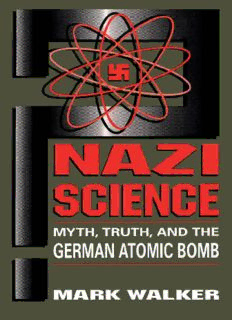
Nazi Science PDF
Preview Nazi Science
NAZI SCIENCE MYTH, TRUTH, AND THE GERMAN ATOMIC BOMB This page intentionally left blank NAZI SCIENCE MYTH, TRUTH, AND THE GERMAN ATOMIC BOMB MARK WALKER PERSEUS PUBLISHING Cambridge, Massachusetts Library of Congress Cataloging-in-Pubiieation Data On file Perseus Publishing books are available at special discounts for bulk purchases in the U.S. by corporations, institutions, and other oiganizations. For more information, please contact the Special Matkets Department at the Perseus .Books Group, 11 Cambridge Center, Cambridge, MA 02142, or call (617) ISBN 0-306-44941-2 © 1995 Mark Walker Published by Perseus Publishing A Member of the Perseus Books Group 109876 All rights reserved No part of this book may be reproduced, stored in a retrieval system, or transmitted in any form or by any means, electronic, mechanical, photocopying, microfilming, recording, or otherwise, without written permission from the Publisher Printed in the United States of America Acknowledgments I am very grateful to the many people who helped me with this project. Preliminary versions of Chapters 8,9, and 10 appeared in Vierteljahrshefte fur Zeitgeschichte (volumes 38 (1990), 45-74 and 41 (1993), 519-42), and Chapters 6 and 7, in Historical Studies in the Physical and Biological Sciences (volume 22 (1992), 339-89). I am indebted to John L. Heilbron and the editorial board of the Vierteljahrshefte for their support and editorial advice. Many of my colleagues read all or part of this book and gave me their helpful criticism: Philippe Burrinh, David DeVorkin, Michael Eckert, Paul Forman, Dieter Hoffmann, Ian Kershaw, Andreas Kleinert, Michael Neufeld, Ray Stokes, Carl Friedrich von Weizsacker, Andreas Wirsching, and my Union College colleagues Steve Berk, Faye Dudden, Erik Hansen, and Teresa Meade. Finally, Linda Greenspan Regan, my editor at Plenum Press, greatly improved the manuscript through her insightful comments and suggestions. This book could not have been written without the generous help of many archives and archivists: the Academy Archives of the Berlin-Brandenburg Academy of Sciences, the Berlin Document v) tn Acknowledgments Center, the Archives of the Humboldt University, the Archives of the Max Planck Society, and the State Prussian Library in Berlin; the State Archives in Hamburg; the Federal Archives in Koblenz and Potsdam; the German Museum, the Institute for Contempo- rary History, and the Max Planck Institute for Physics and Astro- physics in Munich; and the National Archives and Records Services in Washington, D.C, Special thanks go to Helmut Drubba for sending me a great deal of valuable information. I received financial support for my research from the Alex- ander Humboldt Foundation, the Berlin Program of the Social Science Research Council, and Union College. Ulrich Albrecht, Andreas Heinemann-Gruder, and the Free University welcomed me as a guest in Berlin, as did Baudouin Jurdant, Josiane Olff- Nathan, and the rest of GERSULP at the University of Strasbourg. Perhaps most important is the support I have always received from the History Department at Union College. My colleague Monika Renneberg and I have recently edited a collection of essays on science, technology, and National Social- ism.1 I cannot improve on the dedication we used in that book, so I would like to repeat it here. This book is dedicated to all those critical voices who ham tried to illuminate this ambivalent chapter of history, but were unappreciated, ignored, and discouraged. Contents Chapter 1 Introduction 1 Chapter 2 The Rise and Fall of an "Aryan" Physicist 5 Chapter 3 The Alienation of an Old Fighter 41 Chapter 4 The Surrender of the Prussian Academy of Sciences 65 Chapter 5 A "Nazi" in the Academy 95 Chapter 6 Physics and Propaganda 323 Chapter 7 Goodwill Ambassadors 153 oti Dtit Contents Chapter 8 Hitler's Bomb 183 Chapter 9 The Crucible of Farm Hall 207 Chapter 10 The Myth of Hitler's Bomb 243 Chapter 11 Conclusion 269 Abbreviations 273 Endnotes 277 Bibliography 307 Index 317 1 Introduction Was there & peculiarly "Nazi science"? Were there uniquely "Nazi scientists"? These questions are deceptively simple. Even the term "Nazi" is frustratingly difficult to define. A minority of Germans, including National Socialist leaders like Adolf Hitler, Heinrich Himmler, and Josef Goebbels, were certainly "Nazis." An even smaller group, including the small circle of Army officers, churchmen, and aristocrats who tried and failed to assassinate Hitler in 1944, certainly resisted National Socialism. But the conduct and conviction of tens of millions of other Germans were not so clear cut. There is no simple definition for the term "Nazi." Mere membership in the National Socialist German Workers Party does not suffice: there are many examples of party members who opposed Hitler's murderous policies and of non-members who actively supported them. Instead, individual Germans have to be examined and judged on a case-by-case basis, and different observers may come to different conclusions. It is important to distinguish between the minority of scien- tists who happened to be followers of Adolf Hitler and supporters 1
Description: